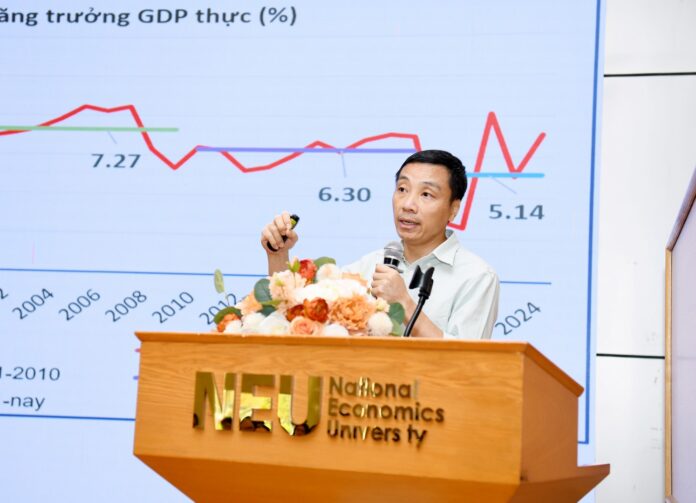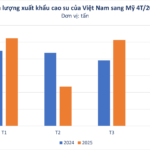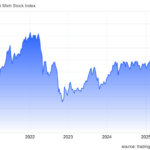“The world is undergoing generational changes, and Vietnam is experiencing revolutionary ones. However, no matter how the world changes and how we evolve, Vietnam must continue to grow,” said
According to Mr. Son, the Party and State have set a clear goal of elevating Vietnam from a lower-middle-income country to a high-income one by 2045. To achieve this ambitious target, there is no alternative but to pursue rapid growth, with an immediate milestone of attaining at least 8% growth in 2025 and sustaining double-digit growth rates in subsequent years.
Learning from the Success of East Asian Economies
Analyzing Vietnam’s economic growth trajectory,

Associate Professor Dr. Pham The Anh, Faculty of Economics – National Economics University
Given the imperative for a model shift to boost economic growth, Mr. The Anh presented a survey of the experiences of East Asian countries such as South Korea, Japan, and China, aiming to distill common formulas for their success in economic development.
A salient feature pointed out by the expert is that these countries had specific strategic plans for each stage of development and selected priority industries. “This is very different from Vietnam, as our country has almost no selection or prioritization of specific sectors,” Mr. The Anh observed.
These economies also focused on export-oriented manufacturing, technology transfer from abroad, investment in domestic research and development (R&D), development of high-quality human resources, economic restructuring, and selective orientation towards sectors with competitive advantages that bring high value-added…
“In each phase, all of the above countries aimed for macroeconomic stability,” emphasized Mr. The Anh.
Concurring with the lessons from East Asian countries, Professor Tran Thi Van Hoa from the National Economics University pointed out that one of the common denominators of these countries is the proactive role of the state in policy formulation and design, especially their long-term development vision and government commitment to that vision.
Which Scenario is Most Suitable for Vietnam’s Aspirations?
Along with the lessons from East Asian countries, formulating growth scenarios to achieve the goal of becoming a high-income country by 2045 is also an important discussion topic. In her paper, Professor Tran Thi Van Hoa posed the questions: “What GDP growth rate does Vietnam need to reach the high-income threshold by 2045? Which growth scenario is feasible?”
According to the professor, the aspiration to leap from a lower-middle-income country with a per capita income of $4,110 in 2024 to a high-income threshold of over $26,835 (according to the research group’s calculations) by 2045 is “an immense challenge in a very complex context.”

Professor Dr. Tran Thi Van Hoa – National Economics University
Given the economic context and using the integrated forecasting method of Management Forecasting and Causal Layered Analysis, Professor Tran Thi Van Hoa proposed three growth scenarios. Among them, Scenario C, based on the “Growth Wave” model, was deemed suitable based on empirical evidence from East Asian countries, which achieved high growth by preparing in the initial stage and accelerating in the subsequent one.
This option is also feasible after a prolonged reform period, offering high flexibility and avoiding “growth shocks” and imbalances.
Scenario C is divided into three phases. Phase I (2025-2035) consists of two sub-periods: 2025-2030, a preparation period targeting 8-10% GDP growth, and 2031-2035, an acceleration period aiming for 11-12% GDP growth. Phase II spans five years (2036-2040), with a GDP growth target of 8.5-9%. Phase III (2041-2045) also covers five years, with a GDP growth target of 6.5-7.5%.
With this scenario, Vietnam’s projected per capita GDP in 2045 is $28,523, and per capita GNI reaches $27,015, achieving the set goal.
Based on this scenario, Professor Tran Thi Van Hoa recommended that in the current phase (2025-2030), Vietnam should focus on institutional completion, infrastructure development, creating incentives for the private sector’s growth, and attracting high-quality FDI through breakthrough incentives for high-tech and semiconductor industries.
Unleashing the Power of Resources: Thuy Nguyen and Hai Phong City’s Journey to a New Era of Success
Recent developments have placed Hai Phong, especially Thuy Nguyen, in the spotlight. A series of events, festivals, and administrative updates have drawn attention to this area, which is now undergoing significant transformation. The focus is on creating a sustainable urban environment with a holistic approach to development, encompassing politics, culture, and commerce, while also integrating a range of amenities and services and enhancing regional connectivity.
Vinhomes Unveils Plans for Two Industrial Parks in Hai Phong with a Massive Investment of nearly $430 Million
Let me know if you would like me to provide any additional revisions or if you have another writing task for me!
The Ngu Phuc Industrial Park (Phase 1), spanning over 238 hectares in Ngu Phuc and Kien Quoc communes (Kien Thuy district), and the Tan Trao Industrial Park (Phase 1), covering more than 226 hectares in Tan Trao and Kien Quoc communes, are set to be the newest and most promising industrial hubs in the region.
The Rainbow After the Storm: Top Brokers and Experts Predict VN-Index Hitting the 1,500 Mark
“Following the ‘tariff shock’, the VN-Index staged a remarkable recovery, prompting optimistic assessments from analysts. “




















